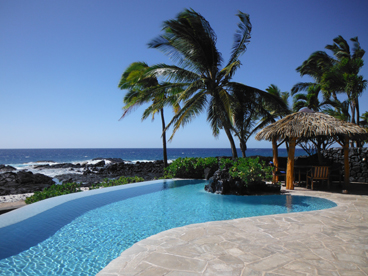Weather
The weather on the Hawaiian Islands is simply unsurpassed as the world’s finest.
A little about Kona by the famous writer Jack London who visited in 1909:
“…a lotus land, where each day is like every other day, and every day is a paradise of days. Nothing ever happens. It is not too hot. It is not too cold. It is always just right. It is a land of perpetual calm…the perfect invalid climate.”
With over 350 days of sunshine, dry, sunny conditions generally prevail along the coastline in the Kona region of The Big Island of Hawaii. There are two seasons – winter and summer, but there is little variation between the two. Aa the coast. Winter average daily high is generally in the low 80’s while the summer average daily highs are in the mid 80’s….a difference of only a few degrees. While the coast is mostly sunny and dry, less than five miles inland on the slopes of Mt. Hualalai in South Kona, afternoon mists and light rains often follow sunny mornings, and this helps to enrich the coffee farms of the area. While the coastal region averages less than 10 inches of rain a year, just a short distance inland the average will double and triple until you reach the Hilo side of the island where the rainforest areas will average several hundred inches a year. The dry leeward coast of The Big Island is protected from the moist clouds of the east by the 13,600-foot summits of Mauna Kea and Mauna Loa and is the most perfect vacation weather of all of the islands, and hence called the “gold coast.”
The Hawaiian Islands in general and Kailua Kona get rave reviews the world over for their unique and desirable environment. Interestingly, outside of the usual clear skies and warmth, the Hawaiian weather can be different from one side of an island to the other. Changes in altitude and weather conditions can be severe – you could experience both snowfall on a mountain or sunburn by the seaside. When exploring Kailua Kona keep in mind that for every 1000 feet you ascend, it gets cooler by 3 degrees Fahrenheit.
We also have some major moisture in our Kailua Kona rainforests and on the northeast facing sides of the islands we get some of the most intense rainfall anywhere. The southwest (or “leeward”) portions of the islands tend to be on the dry side and less windy. The climate in Kailua Kona is conducive to so many wonderful experiences that Hawaiian vacationers consistently report. Imagine yourself hiking up to a snowy volcano top or lounging seaside in the sun- Hawaii weather has it all.
Monthly Climate Summary
| Month | High | Low | Ocean |
| January | 80°F | 66°F | 72°F |
| February | 81°F | 66°F | 72°F |
| March | 82°F | 67°F | 71°F |
| April | 82°F | 68°F | 72°F |
| May | 84°F | 70°F | 72°F |
| June | 84°F | 71°F | 74°F |
| July | 85°F | 72°F | 74°F |
| August | 86°F | 73°F | 75°F |
| September | 86°F | 73°F | 75°F |
| October | 85°F | 72°F | 75°F |
| November | 83°F | 70°F | 74°F |
| December | 81°F | 67°F | 73°F |

Big Island Weather
Of the thirteen climate zones in the world, the Big Island has eleven of them, so pick a spot. If you want wet and rainy weather, try the Hilo side. For warm and dry weather, go to the Kona side. If you want a desert, head south, a rain forest, go to Puna, and if you want to ski in the winter, go to Mauna Kea. If you’re looking for ideal weather, then come to Kona. If you move up the slopes of Hualalai, you get into the clouds, and if you go high enough you get rain everyday. That rain is the source of fresh water for the Kona coast. The almost daily rains percolate into deep lava tubes that drain into underground wells. Much of the fresh water can be seen running into the ocean along the shore line, especially after heavy rains. By moving up the mountain slopes you can pick the temperature you wish to experience. The higher you get, the cooler the outside air. There are people living above the 2,000′ level that actually have heat in their homes. Back at sea level, a unique rain pattern emerges. It usually rains only at night. Most mornings are crystal clear with clouds forming in the afternoon. By sunset, which is almost always visible, the clouds begin to clear away and there are beautiful, starry nights. Summer runs from May through October and is warmer and just slightly wetter than winter. From November through April, the weather is just slightly cooler and drier. The coldest temperature ever recorded was a frosty 58°F, and the all time high was 95°F. It doesn’t get much better than this!























